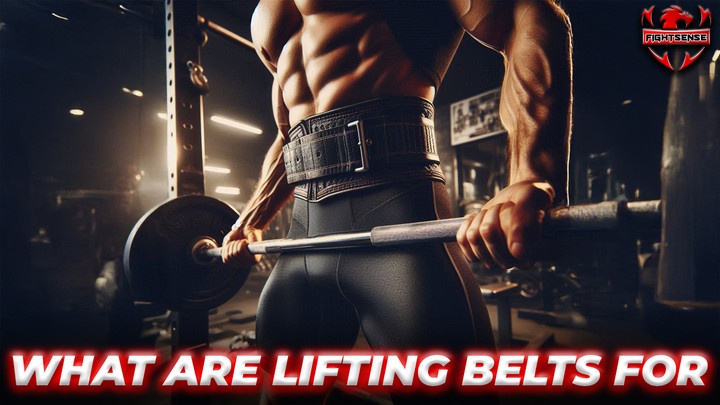What Are Lifting Belts For? Benefits and Usage Tips
26th Mar 2025
What Are Lifting Belts For? A lifting belt has been a trusted companion in strength training for decades, yet many beginners still wonder about its true purpose. More than just an accessory, it’s a powerful tool that enhances performance, protects the lower back, and provides core stability during heavy lifts.
In this article, we’ll break down what lifting belts are for, their key benefits, and how to use them effectively in your training program.
Key Highlights
-
Lifting belts improve spinal stability and support during big lifts.
-
Through core stabilization, they assist lower injury risk.
-
Enhancement of lifting performance and technique depends on lifting belts.
-
They are appropriate for many workouts and all ability levels.
-
For strength athletes looking to lift more safely and effectively, lifting belts are absolutely essential.
What Are Lifting Belts For?
What are lifting belts for? Lifting belts improve your lifting performance by supporting your lower back and core. A lifting belt mostly serves to raise intra-abdominal pressure, which stabilizes your spine during big lifts such as deadlifts, squats, and overhead presses.
-
Reduces lower back tension
-
Increases stability
-
Decreases injury risk
-
Protects spine and strengthens core
What Are Weight Lifting Belts For?
-
Weightlifting belts support the lower back and stabilize the spine.
-
They compress the abdominal cavity, preserving spinal integrity during lifts.
-
Crucial for exercises like squats and deadlifts where the lumbar spine is under strain.
-
Useful for high-load, compound movements to enhance technique and reduce injury risk.
-
Supports various goals like maximal strength, hypertrophy, and endurance.
Benefits of Lifting Belts
You should already be quite aware of What are lifting belts for. Let us now explore more the benefits they present, though:
-
Increased Safety: Lifting belts guarantee correct posture and core engagement during large lifts, therefore helping to stabilize the spine and prevent lower back ailments.
-
Better Performance: Using a lifting belt helps your core be correctly engaged, thereby facilitating the lifting of larger weights and optimal efficiency in exercises.
-
Improved Core Activation: The belt generates intra-abdominal pressure, therefore assuring that your abdominal muscles cooperate with the rest of your body and hence provide better muscular activation.
-
Versatility in Training: Lifting belts are helpful for a broad spectrum of workouts and ability levels regardless of your training level—from novice to experienced.
What Are Lifting Belts Good For?
In the broad sense then, what are lifting belts for? For lifters who wish to increase performance while preserving spinal health, lifting belts especially help. Their main advantages break out here:
-
Prevention of Injuries: A lifting belt keeps a neutral spine and gives the lower back essential support, therefore preventing hyperextension or rounding during lifts.
-
Enhanced Lifting Performance: Because your core is stabilized with correct abdominal pressure, you can lift more weight and execute more difficult exercises.
-
Better Posture and Technique: Improving posture and technique, especially during compound workouts, is facilitated by the use of lifting belts. This helps you keep good alignment, lowering your chance of poor form and possible injury.
What Are Lifting Belts Used For?
Exercises requiring spinal stability and core strength for certain purposes call for lifting belts. The most often performed exercises using lifting belts consist in:
-
Squats: Especially while lifting big weights, a belt supports the lower back and core during squats, reducing damage and stabilizing your posture.
-
Deadlifts: Particularly when lifting heavy weights, a lifting belt assists in maintaining spine alignment. The belt helps to lessen back strain and raises core pressure.
-
Overhead Lifts: Lifting belts are applied during overhead presses to help stabilize the core and guarantee a solid, under-control lift.
How to Use Lifting Belts Correctly
These guidelines can help you maximize a lifting belt:
-
Here are the main points highlighted:
-
Adjust the Belt Properly – Fit tightly 1–2 inches above hips, strong but not constrictive.
-
Use for Heavy Lifts – Wear during squats, deadlifts, overhead presses.
-
Engage Your Core – Breathe into your belly and push against the belt.
-
Don’t Over-Rely on the Belt – Train core without the belt too.
-
Maintain Proper Form – Belt aids lifts but does not replace correct technique.
-
Shop Now !
Last Thoughts
What are lifting belts for? They are essentially instruments that protect your spine and help raise your lifting capacity. Including a lifting belt in your training program will help you with posture, stability, and lifting technique whether your goals are strength, endurance, or total fitness.
One good approach to safely exceed your boundaries is to use a lifting belt, therefore lowering the danger of injury and optimizing performance.
Disclaimer
This blog offers broad guidance on fitness. Before beginning a new exercise program—especially if you have pre-existing ailments or injuries—always see a qualified trainer or medical practitioner.

